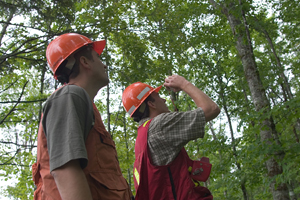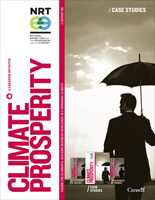J.D. Irving, Limited – Case Study
FACING THE ELEMENTS: Building Business Resilience in a Changing Climate
AT A GLANCE // |
Location:Saint John, New Brunswick Industry:Wood product manufacturing Employees (2010):15,000 Total sales (2010):over C$50 million |
Key adaptation
|
Adaptation
|
Business BenefitsIncreased economic value of forest land Improved resilience through genetic diversity |
COMPANY OVERVIEW //
SAINT JOHN, NEW BRUNSWICK
www.jdirving.com

(photo credit: J.D. Irving Limited)
The company’s forestry operations are located in eastern Canada (New Brunswick, Nova Scotia, Prince Edward Island, Newfoundland and Labrador, Québec, and Ontario) as well as the U.S. (State of Maine). J.D. Irving’s forestry activities are extremely important in the Atlantic Provinces: in the last 50 years, the company has achieved a national record by planting over 850 million trees.
Compared to other Canadian forestry companies, J.D. Irving owns a considerable amount of land in New Brunswick, Nova Scotia and Maine (U.S.). Approximately 1 million of the 2.3 million hectares of land it manages is leased from the Province of New Brunswick.
In both Canada and the U.S., the forests owned or managed by the company are certified under the Sustainable Forestry Initiative. JDI’s woodlands in Maine also are certified under the Forest Stewardship Council (FSC) program.
The company produces a number of forest-based products including the following: pulp to produce paper or tissue; printing paper of different grades; tissue paper for facial tissues or napkins packaging material for food and other consumer products; and lumber products for construction, building finishing materials.
J.D. Irving Limited sells most of these products in Canada and the U.S. The company’s tissue brands include MajestaTM, RoyaleTM and Scotties (U.S.) tissuesTM.
FOREST MANAGEMENT AND FOREST PRODUCT MANUFACTURING IN A CHANGING CLIMATE
The impacts of climate change are already being felt in the forestry industry.41 For example, consider the following:
// In recent years, considerable fire activity has affected Western Canada.42 Though fire disturbance in Atlantic Canada has been low in the past, climate model projections indicate a future increase in fire hazard.43
// There is evidence that extreme weather events, such as storms and droughts, have become more severe and frequent in Atlantic Canada in recent years.44
// The frozen ground season has decreased in recent years, making it more difficult to harvest timber in wet areas or where soil could easily become compacted by the use of heavy machinery.
The bioclimatic suitability of tree species in Atlantic Canada will shift due to a changing climate. For example, black spruce (the dominant tree species in the boreal forest of Labrador) could see its net productivity increase with higher springtime temperatures.45
Increased drought, due to reduced summer precipitation and higher temperatures, will likely put at risk natural regeneration, as well as mature forests.46 The increased number of cycles of freezing and thawing could also affect a number of tree species, especially those with shallow roots, such as spruce.
Changing pest and disease dynamics may compound with direct climatic stresses (such as heat or drought) to damage forests. For example, the spruce budworm is the single biggest threat to forests in New Brunswick. Though scientific uncertainty remains, there is evidence that higher summer temperatures and milder winters could cause a northward shift in the distribution of this insect and more severe and prolonged outbreaks in areas already affected by it.47
Increased drought will extend the fire season and increase fire hazard, putting more forest hectares at risk of loss or damage.
Climate change has the potential to increase storminess in Atlantic Canada, including extreme wind speeds, which is a known determining factor of tree damage.48
Climate change may also affect wood manufacturing activities, though impacts are less well understood. For example, weather-related delays and disruptions to transport of wood products could increase.
Climate change could also affect international sales. Two studies suggest that Canadian forest product companies are particularly vulnerable to climate change impacts compared with competitors from other countries.49
Finally, a number of forest ecosystem services are vulnerable to a changing climate, such as biodiversity and carbon sequestration. This will likely affect not only the environmental performance of forest management activities, but also the standard of living of forest-based communities. The reputation of forestry companies could be affected by such impacts, especially since government and public scrutiny of timber harvesting activities are increasing. As evidence, a number of sustainable forest management certification schemes have started integrating climate risk management into their standards and audit requirements.k
DRIVERS
J.D. Irving Limited has observed changes in climate in recent years, such as milder winters and an earlier spring season. This has had a discernable effect on winter harvesting already. The company has considerable timber in areas that need to be harvested while soils are frozen. Reduced winter freezing and earlier ice melting make it more difficult to access these areas.
Long-term forest productivity is critical to JDI’s, Limited’s economic success and environmental performance. This is why all land under JDI’s stewardship is covered by a Management Plan, which includes long-term forecasts extending 80 years into the future for wood supply, forest communities, habitats and other land management values. These plans are re-evaluated on a five-year cycle. Climate change will have an impact on long-term forest management plans and wood flow forecasts, thus affecting revenues, budgets for modernization and overall competitiveness. This is an important driver for building climate change resilience for JDI.
A FOCUS ON BOOSTING FOREST RESILIENCE
J.D. Irving Limited does not have an explicit climate change adaptation strategy. Instead, risk management including potential effects of climate change is an integral component of its land stewardship commitment. This is embedded in forest management across forest areas and forest types managed by the company.
First, JDI recognizes that in order to manage future climate change successfully, the company needs to have a good understanding of local bioclimatic conditions, including climate, soil and ecology. Appropriate site-by-site decision making lies at the forefront of climate change adaptation strategies for forest management. This means ‘doing the right things in the right places’. Using appropriate harvest methods, stand tending and regeneration techniques across the range of forest types including softwoods, hardwoods and mixed forests is an integral part of forest operations.
A mixture allowing natural regeneration and establishing planted stands is employed according to the forest type and condition. Hardwood stands are typically regenerated using natural regeneration that is related to the prolific seeding and sprouting of hardwoods. Softwoods are regenerated through natural regeneration or by establishing planted stands. When planting trees, great attention is paid to selecting the best species or mixture of species for the specific site.
J.D. Irving Limited has started making changes to silvicultural decisions with knowledge of climate change impacts in mind. For example, balsam fir in Southern New Brunswick suffers from balsam woolly adelgid, a pest that damages and kills the trees and is favoured by mild winters. A changing climate will create more favourable conditions for this pest. As a result, the company often plants a mixture of resistant tree species, such as spruce and pine rather than relying too much on balsam fir natural regeneration, in part to increase resilience to climate change related damage.
Secondly, JDI invests in actions that maintain or improve forest health. Overall, healthy forests are more capable of withstanding climatic stresses, such as drought or windstorms, than already stressed forests. JDI maintains vigorous tree growth with an active thinning program. This is not strictly implemented as part of a climate change adaptation strategy, but it builds resilience nonetheless. It also improves carbon sequestration in the long term.
J.D. Irving Limited has a tree genetics improvement program based on selection of the highest quality trees in forests across the region. These superior trees are grafted and planted in seed orchards to produce seed for use in reforestation stock production. Traditional breeding is conducted among the selected trees and resulting offspring are planted in replicated field tests across the region. These are measured over time, beginning five years after they are planted. Field test tree growth analyses are used to understand genetic variation and how trees in the tree improvement program perform in different sites and climates. This also helps in understanding how the trees will respond in changing climate conditions. On average, the company measures 30,000 trees each year to support these efforts.
Such work is made possible because JDI’s land holdings have a large number of different bioclimatic characteristics. For example, the number of frost-free days varies between 90 and 170 across JDI’s land holdings, which the company sees as a much larger climatic difference than the projected future climatic changes over the next 50 years.
Finally, JDI has made significant investments in fire risk management for many years. For example, the company owns five fixed-wing aircrafts and two helicopters, which it keeps on standby during the fire season. The company expects these investments to help to reduce vulnerability to possible future increased fire hazard.
BENEFITS AND/OR CHALLENGES
Overall the company spends $1.5 million on research per year, often in collaboration with universities and government. Not all of this money is spent on adaptation. In fact, JDI recognizes that a lot of its adaptation efforts correspond with good sustainable forest management practices. This makes it difficult to assess the cost and benefits of adaptation actions.
For example, through its tree genetics improvement program and forest management practices the company expects to increase the economic value of its forest land and maintain broad genetic diversity that coincidentally builds climate change resilience.
Another important aspect related to JDI’s approach to sustainable forest management and climate change is the overall carbon footprint. Carbon sequestration estimates are frequently made with respect to only one or a few components of the continuum of carbon dynamics from the forest through to product lifecycle. Understanding and integrating carbon accounting is necessary from the standpoint of economic and ecological service values of management options.
PERSPECTIVES ON GOVERNMENT ROLES
The potential economic implications of climate change are considerable for the industry. Although natural genetic variation will help cope with climate variability and long-term climatic changes in the next 50 years, the forest sector needs to start bringing in new tree species that are resistant to future climate change. This form of adaptation should be implemented gradually, since the effect of shortterm natural climatic variability (for example, colder than usual winters) can cause significant damage to newly introduced trees that are not as tolerant to local environmental variation.
This type of research and development is best done through public-private co-operation, since it is resource-intensive, costly and requires a broad genetic pool. The New Brunswick Tree Improvement Council (NBTIC) is a good example of public-private collaboration that can help build climate change resilience. The NBTIC assists the exchange of genetic information and material between agencies, companies, and universities.l
Government can also facilitate adaptation in the forestry sector by re-defining tree breeding zones to take account of future climate change, as well as improving soils and site information for better decision making on the ground.
Finally, federal and provincial governments should continue to support research on climate change. However, it is important to address both research on impacts and research on adaptation solutions.
[k] For example, the new version of the Canadian Standard Association standard for sustainable forest management (Z809-08, Sustainable Forest Management) has provisions for exploring climate change impacts and adaptation. The Forest Stewardship Council or FSC (another leading international certification and labelling scheme) is exploring possible strategic engagement options on climate change adaptation. See Canadian Standards Association 2008 and Forest Stewardship Council Forest Carbon Working Group 2010.
[l] For more information, see New Brunswick Forest Products Association ND.
[41] Johnston et al. 2010
[42] Johnston et al. 2010
[43] Government of New Brunswick 2007; Vasseur and Catto 2008
[44] Government of New Brunswick 2007; Vasseur and Catto 2008
[45] Government of New Brunswick 2007; Vasseur and Catto 2008
[46] Government of New Brunswick 2007; Vasseur and Catto 2008
[47] Régnière 2009
[48] Régnière 2009
[49] Perez-Garcia et al. 2002; Sohngen and Sedjo 2005









































